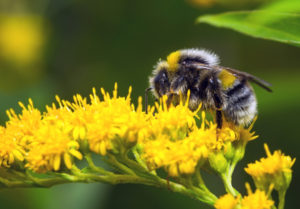
Bumblebee (Bombus pascuorum) on a yellow flower
by HBI
For nearly 50 years, the fruit fly Drosophila melanogaster has occupied center stage in the world of neuroscience. Fruit flies are small, plentiful, easy to manipulate and have a lifespan well-suited to laboratory research. Their genome has been extensively studied and methods have been developed to analyzed behaviors as diverse as sleeping, eating, mating, learning, memory and various aspects of sensory perception.
But fruit flies are not the only insects that hold answers for scientists interested in the cells, circuits and social strategies underlying behavior. Why? Despite all their genetic advantages, the behaviors of fruit flies might be seen as a bit boring compared to those of many other insects, particularly when it comes to social behaviors. Recently, bees and ants have begun to play key roles in neuroscience research. At Harvard alone, at least five labs have turned to these non-traditional model organisms to answer questions about social and navigational behaviors:
- In October, researchers from the lab of Venkatesh Murthy published a report on how carpenter ants use antennae to navigate their worlds—sensing odors and turning that sensory information into motor outputs as they follow trails of species-specific pheromones laid out by others in their colony. (See NY Times highlight.)
- Also in October, researchers from the labs of Naomi Pierce, Hopi Hoekstra and colleagues published a study on halictid or “sweat” bees. This is a family of bees in which there can be significant intra-species variation—with some populations producing solitary nests and others producing nests with advanced social organization—and the researchers uncovered the genetic basis of this social polymorphism.
- In November, researchers from the labs of Benjamin de Bivort, Naomi Pierce and colleagues published a study on the harmful impact of pesticides on a variety of vital social behaviors in bumblebees, from nursing the young to regulating nest temperature. (See Harvard Gazette story.)
- In January, researchers from the lab of L. Mahadevan published another report on thermoregulation in bees—this one focused on honeybees, describing and mathematically modeling how they collectively ventilate their nests on hot summer days under more typical environmental conditions, sans pesticides. (See SEAS news highlight.)
Together, these new papers reveal the potential that highly social insects like ants and bees hold for exploring the role of individual organisms and their neural circuits in complex group behaviors.
“The reason to study non-model system insects is that they perform an interesting behavior that your genetic model organisms don’t,” says Benjamin de Bivort, Associate Professor of Organismic and Evolutionary Biology at Harvard. “Flies have interesting social behaviors, but they don’t, to our knowledge, have anything like the full societies that social insects like ants and bees have. By studying social insects, you can study the rules by which complex collective behaviors arise from individual actions, and social relationships like altruism.”
“Ants, bees and wasps are the best-known example of the non-Drosophila extreme – individuals living in colonies and famously sacrificing their own reproduction in order to help another, the queen, produce more offspring – but there are other insect groups that also lead quirky self-sacrificial social lives, including some cockroach species, termites, and even in some cases, the humble aphid,” notes Naomi Pierce, the Hessel Professor of Biology at Harvard.
She explains that Darwin was puzzled by the altruism exhibited by highly social insects like these, where there may be extreme self-sacrifice for the good of the colony. But much progress has been made in understanding why these behaviors evolved.
“Only in recent years, with the increasing ability to apply tools developed for model organisms to non-model organisms has it been possible to track all the individuals in a colony at once, to analyze and manipulate their genome, and to begin to tease apart genetic and environmental factors affecting their extraordinary group dynamics,” Pierce says. “It’s an exciting time to return to studying these non-model organisms, especially at Harvard, where thanks to Edward O. Wilson and others, so much has already been done to unravel social behavior.”
News Types: In the News
